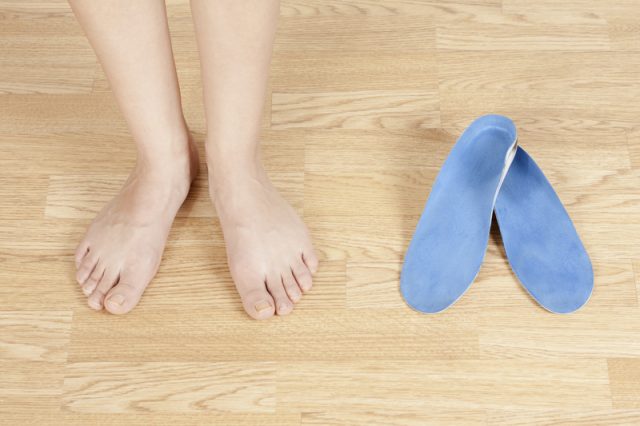If I am too old for orthotics what is the point?

Research
Effectiveness of a multifaceted podiatry intervention to prevent falls in community dwelling older people with disabling foot pain: randomised controlled trial
BMJ 2011; 342 doi: http://dx.doi.org/10.1136/bmj.d3411 (Published 16 June 2011) Cite this as: BMJ 2011;342:d3411
Introduction
Falls in older people are a major public health problem, with 1 in 3 people aged 65 and over falling each year.12 It is well recognised that falls result from the interaction between environmental hazards and physiological risk factors, such as impaired vision, muscle weakness, and slow reaction time.1234 More recently, foot problems, which affect 1 in 3 older people567 and are a common reason for consultation in primary care,8 have been associated with falls. Specifically, foot pain, reduced range of motion, toe weakness, and toe deformity have each been shown to be independent risk factors for falling.910 In addition, footwear related risk factors for falls include walking barefoot, walking in socks alone or wearing shoes with inadequate fixation (that is, no laces, straps, or buckles), increased heel height, and reduced contact area of sole.11121314
Given the emerging evidence that foot problems and inappropriate footwear increase the risk of falls, several guidelines for falls prevention recommend that older people have their feet and footwear examined by a podiatrist.15161718 These guidelines do not, however, specify the assessment or intervention activities to be undertaken, and few randomised controlled trials have been carried out to inform clinical practice. Three multifactorial intervention studies have included assessment of participants’ feet and footwear as part of the protocol, with referral to a podiatrist when appropriate.192021 However, the criteria for referral to a podiatrist were not described nor was there any analysis of the effectiveness or benefit of such referrals. Only one trial has been undertaken in relation to footwear, which specifically focused on a modification to reduce slipping on icy surfaces.22
To deal with this gap in the literature and to determine whether podiatry has a role in falls prevention, we carried out a randomised controlled trial to determine the effectiveness of a novel, multifaceted podiatry intervention addressing foot and footwear risk factors in reducing the rate of falls in older community dwelling people with disabling foot pain.
Methods
Between July 2008 and September 2009 we recruited participants by post using a database of people who were accessing podiatry services at the La Trobe University Health Sciences Clinic, Bundoora, Victoria, Australia, and by advertisements in local newspapers and on the radio. Participants were eligible if they were community dwelling, were aged 65 years or over, were cognitively intact (defined as a score of ≥7 on the short portable mental status questionnaire),23 reported disabling foot pain (defined as foot pain lasting for at least a day within the last month and a positive response of “some days” or “most/every days” to at least one item on the Manchester foot pain and disability index),24 and had an increased risk of falling (defined as either a history of a fall in the previous 12 months, a score of >1 on the physiological profile assessment tool,3 or performance on the alternate stepping test of >10 seconds).25 Exclusion criteria included neurodegenerative disorders, leg amputation, inability to walk household distances (10 m) without the use of a walking aid, limited English language skills, and leg surgery three months before the initial assessment or planned leg surgery within a period of three months of the planned initial assessment.
Conclusions
The findings of this study show that a multifaceted podiatry intervention is an effective falls prevention strategy in older people with disabling foot pain and an increased risk of falls. The reduction in falls is likely to be related to the significant improvements found in several measures of foot and ankle strength and range of motion, balance, and functional ability. The components of the intervention are inexpensive and relatively simple to implement, suggesting that the programme could be incorporated into routine podiatry practice or multidisciplinary falls prevention clinics.
What is already known on this topic
Foot problems impair balance and gait and increase the risk of falls
Inappropriate footwear impairs balance and increases the risk of falls
What this study adds
A multifaceted podiatry intervention consisting of a foot and ankle exercise programme, foot orthoses, advice on footwear, subsidised footwear, and general falls education significantly reduced the rate of falls in community dwelling older people with disabling foot pain




